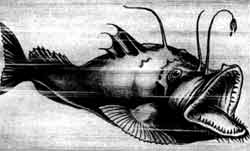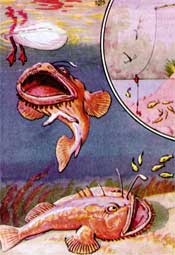|

 Angler Table Manners: The anglerfish is able to distend both its jaw and its stomach (its bones are thin and flexible) to enormous size, allowing it to swallow prey up to twice as large as its entire body. Angler Table Manners: The anglerfish is able to distend both its jaw and its stomach (its bones are thin and flexible) to enormous size, allowing it to swallow prey up to twice as large as its entire body.
Like Moths to a Flame: As most anglerfish live mainly in the oceans' aphotic zones, where the water is too deep for sunlight to penetrate, their predation relies on the "lure" being bioluminescent (via bacterial symbiosis). In a related adaptation, anglerfish are dull gray, dark brown or black, and are thus not visible either in their own light or in that of similarly luminescent prey.
Walking and Talking: Some benthic (bottom-dwelling) forms of anglerfish have arm-like pectoral fins which the fish use to walk along the ocean floor.

 Some anglerfish have an unusual method of mating. Since anglers are few and far between, finding a mate can be difficult. When scientists first started capturing ceratioid anglerfish, they noticed that all of the specimens were females. These individuals were a few inches in size and almost all of them had what appeared to be parasites attached to them. It turned out that these "parasites" were the remains of male ceratioids. Some anglerfish have an unusual method of mating. Since anglers are few and far between, finding a mate can be difficult. When scientists first started capturing ceratioid anglerfish, they noticed that all of the specimens were females. These individuals were a few inches in size and almost all of them had what appeared to be parasites attached to them. It turned out that these "parasites" were the remains of male ceratioids.
When a male anglerfish hatches, it is equipped with extremely well developed olfactory organs that detect scents in the water. They have no digestive system, and thus are unable to feed independently. They must find a female anglerfish, and quickly, or else they will die. The sensitive olfactory organs help him to detect the pheromones of a female anglerfish. When he finds a female, he bites into her flank, and releases an enzyme which digests the skin of his mouth and her body, fusing the pair down to the blood vessel level. The male then atrophies into nothing more than a pair of gonads that release sperm in response to hormones in the female's bloodstream indicating egg release. This is an extreme example of sexual dimorphism. However, it ensures that when the female is ready to spawn, she has a mate immediately available.

Anglerfishes are bony fishes in the order Lophiiformes.
The anglerfish is a culinary speciality in certain Asian countries. In Japan each fish sells for as much as USD 150; the liver, great delicacy, can cost USD 100.
All text is available under the terms
of the GNU Free Documentation License
|